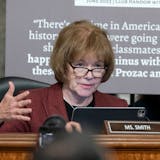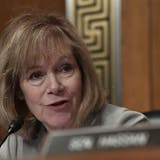The Twins have narrowed the field of candidates to "a group of five to six, probably," for the first pick in the June 12 draft, Derek Falvey said Wednesday, and roughly a dozen scouts and supervisors have seen each one in person. But "there are questions we want to answer with each of these players," he said, so no decision will be made before the entire scouting staff assembles at Target Field next Monday.
Falvey, handed the draft's most valuable asset in his first season as chief baseball officer, has the final say over whether the Twins choose high school phenom Hunter Greene, Louisville lefthander Brendan McKay, Vanderbilt righthander Kyle Wright — all of whom have been projected by various draft analysts as the Twins' ultimate choice — or go another way. "It's an organizational decision, and it's a responsibility that I have," Falvey said. But General Manager Thad Levine and scouting director Sean Johnson have that responsibility, too, he said. "I'm confident we're going to make [the decision] collectively. We're go to get to it together."
First, the Twins will bring a handful of top prospects to Target Field for private workouts. Falvey did not mention any names, but Greene, a righthanded pitcher and shortstop at Notre Dame High in Sherman Oaks, Calif., is expected in Minnesota three days before the draft. "I view that as not necessarily something about talent, but more to get to know the player a bit more," Falvey said. "Taking [batting practice] and running a 60, seeing a guy throw a bullpen, it's helpful but maybe not the deciding factor."
The Twins will also "ask some difficult questions," he said, because the team understands that the overall No. 1 pick will have to deal with a perpetual spotlight until he reaches the major leagues. The extra attention "does create pressure, no question," Falvey said. "That's where all the focus is. That's why it's so importantly critical not only to evaluate the player's talent, but also to think about the makeup and what drives this player to be successful."
One important part of the equation that hasn't been discussed yet: Money. Under MLB's slotting system, the Twins are allowed to pay a bonus of $7.77 million to the top overall pick, and $14.1 million for their entire draft class, more than any other team. No bonus numbers have been discussed with players yet, Falvey said, but it will become part of the evaluation process.
That's because in recent years, teams with high picks have chosen players who agreed to accept less than their "slot" amount, and used the savings later in the draft to convince players who intended to go to college to sign for amounts higher than their slot. The Phillies used that strategy last year, for instance, in choosing outfielder Mickey Moniak and signing him for $6.1 million, $3 million less than that year's limit.
"I wouldn't rule that out," Falvey said. "We'll certainly talk about that strategy, but I'm not yet ready to say it's something we'd do in the first round."
Whoever they take, it's likely the Twins will insist that the top choice pick a position. Greene throws 100 mph fastballs but is also an elite hitting shortstop, and McKay is a slugging first baseman as well as the top lefthander in the draft. It's probably not realistic for a professional to do that, though, especially with so much money invested in his success.


